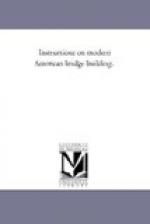14.014 : 20 :: 2000 : 2854—lbs.
The greater the angle of inclination from the horizontal, the less the strain from a given load—and when the beam is vertical the weight causes the least strain.
=Compression.= If we load a vertical post with a weight of 2000 lbs., the strain of compression exerted upon the post will be 2000 lbs. Now, if we incline the post—the strain will be increased, as we have shown above under the head of tension, and in like manner, dependent upon the inclination.
But when wood, iron, or any other material is used for a pillar or strut, it has not only to resist a crushing force, but also a force tending to bend or bulge it laterally.
A post of circular section with a length of 7 or 8 diameters will not bulge with any force applied longitudinally, but will split. But if the length exceeds this limit—it will be destroyed by an action similar to that of a transverse strain.
A cast iron column of thirty diameters in length, is fractured by bending; when the length is less than this ratio—by bending and splitting off of wedge shaped pieces. But by casting the column hollow, and swelling it in the middle, its strength is greatly increased.
Barlow’s formula for finding the weight that can be sustained by any beam, acting as a pillar or strut, before bending, is:—
WL squared bd cubed x 80 E ---- = bd cubed, whence W = ----------- 80 E L squared
[TeX: $\frac{WL^2}{80 E} = {bd^3}$, whence $W = \frac{{bd^3} x 80 E}{L^2}$]
now, having the weight given, and assuming the dimensions of the cross-section—we shall have
----- / WL squared WL squared d = cubed/ -----, and b = ------ \/ 80 Eb 80 Ed cubed
[TeX: $d = \sqrt[3]{\frac{WL^2}{80 Eb}}$, and $b = \frac{WL^2}{80 Ed^3}$]
in the above formulae,
W = weight in pounds. L = length in feet. E = a constant. b = breadth in inches. d = depth in inches.
=Transverse Strains.= The strain caused by any weight, applied transversely, to a beam supported at both ends, is directly as the breadth, and square of the depth, and inversely as the length. It causes the beam to be depressed towards the middle of its length, forming a curve, concave to the horizontal and below it. In assuming this form—the fibres of the upper part of the beam are compressed, and those of the lower part are extended—consequently there must be some line situated between the upper and lower surfaces of the beam where the fibers are subjected to neither of these two forces, this line is called the neutral axis.
These two strains of compression and extension must be equal in amount—and upon the relative strength of the material to resist these strains, as well as its form and position, the situation of this axis depends. If wood resists a compression of 1000 lbs. per square inch of section, and a tension of 2000 lbs. the axis will be twice as far from the top as from the bottom in a rectangular beam.




